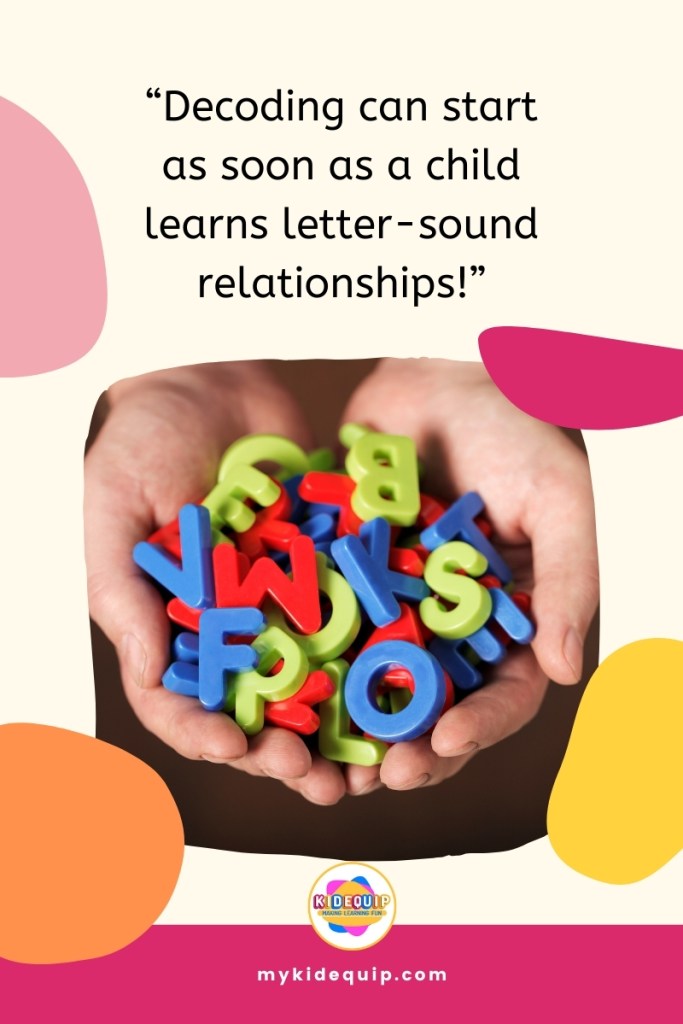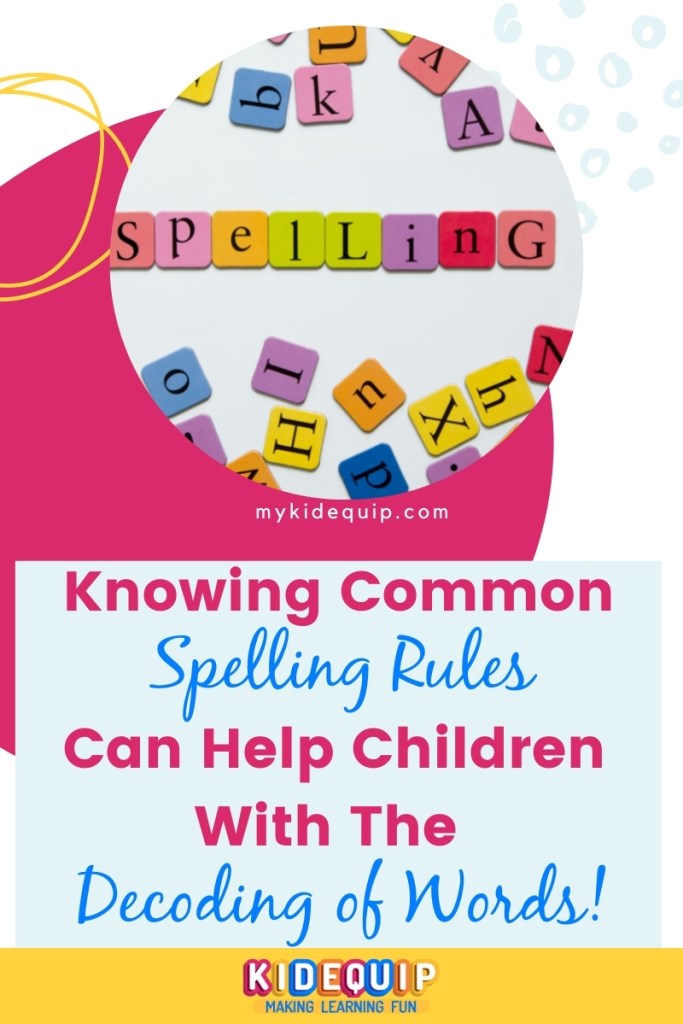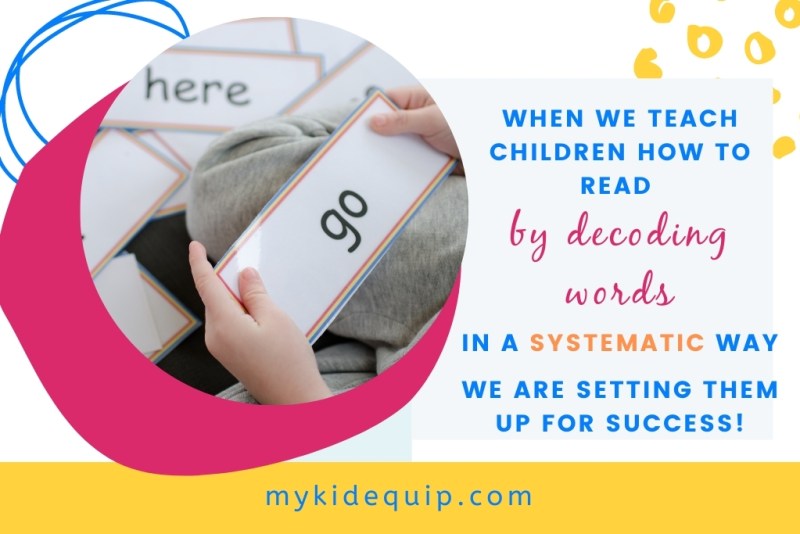The decoding of words is one of the most amazing things our brains can do! One of the things that excites me is when I see a child begin to read for the first time. This is especially awesome when they thought they couldn’t do it, or have struggled for a long time. It is so hard for teachers to know what to do when a child is stuck and can’t progress.
The answer can be as simple as taking them right back to the basics of decoding words.
If your child is struggling to read and is not progressing, this blog post is for you.
I also encourage you to grab my free guide for struggling readers. There are a few things you need to make sure of before you proceed. This guide will take you through exactly what those steps are. This is especially helpful if you suspect a learning difficulty like dyslexia.
Pop in your details below, to get it sent straight to your inbox 📬
Now let’s get on to the decoding of words!!
What does ‘decoding words’ mean?
Decoding is the most important foundation for reading. Without decoding skills, children will not be able to read fluently. This in turn will affect their vocabulary development and comprehension!

Decoding is the ability to take letter-sound knowledge and be able to blend those sounds together to make words.
- For example, if a child knows the sounds that the letters ‘m’ ‘a’, and ‘t’ make, they can blend those sounds together to read the word ‘mat’.
- Once a child knows the individual letter sounds they can progress to learning different letter combinations. There are 44 sounds (phonemes) in the English language. For example, if you put together the letters ‘s’ and ‘h’, they make one sound /sh/. This sound is one phoneme made from two single letters.
Did you know that decoding can start as soon as a child learns letter-sound relationships? They can actually read quite a few words even if they only know the letter-sound relationships for 3 letters.

The first thing I do with all of the children that I tutor is to make sure they:-
- Know their letter sounds and
- Have strong phonemic awareness.
Phonemic awareness is the awareness of sounds in words. It can actually be done with your eyes closed. For example, if I say the word ‘truck’ and ask what sound you hear on the end of the word you will be able to say the sound /k/ if you have good phonemic awareness.
You can continue to work on advanced phonemic awareness skills as your children get more skilled. Being able to manipulate sounds in words to make new words is more advanced. If I ask you to change the vowel sound /u/ to /i/ in the word ‘truck’ and tell me what word you have, you will be able to tell me it is the word ‘trick’. This kind of skill is vital if we are to learn how to decode words.
To find out more about phonemic awareness you can check out my in-depth blog post where I talk about this. Click here.
How to teach decoding words.
Once a child is aware that words are made up of sounds and that those sounds are represented by letters, it is time for them to start to decode.
I always start simple and will begin by putting out one short vowel sound and some consonant sounds and putting them together to form simple words.
With these four sounds you can make these simple 2 letter combinations:
as at & am
- I would say the word out loud and see if the child can pick out the right letters that make those words and put them in the right order.
- If a child cannot hear which order the sounds are heard, it indicates to me that they need to go back to working with sounds alone, without the letters that represent them. This is when I get out the manipulatives and use blocks, Lego or Playdoh to represent the sounds and ask them again.
- Once a child can do this confidently, I would increase the number of sounds to 3. We call these words CVC words as they contain a consonant then a vowel and then a consonant.
With the four sounds mentioned above you can also make:
sat mat & Sam

It is important to have some different strategies for decoding words.
Successive Blending
Successive blending is a strategy that I have found helpful with children who are struggling to hear the vowel sound in the middle.
You start with the first and second sound and then put them together before adding the last sound. In order to hear the vowel sound in the middle, I will tell them to STRETCH it out.
Take a look at these stretchy successive blending strips that I made to help with this.

You turn the strip of paper or card over and get the child to pull it through their fingers slowly stretching out the vowel sound.
Check out this short YouTube example of how to use them here. You can easily make these yourself, or grab my decoding resources made for you by clicking here.
Multisensory Methods
For a child to be able to read words they need to be able to pull the words apart. I have found the best way to teach decoding words is by using multisensory strategies. I use a whole range of activities to help children to develop decoding skills.
- Firstly I will introduce a focus sound. Let’s use the example of the digraph ‘sh’.
- We will each write it down on a whiteboard and then look at how our mouths produce the sound.
- I will then do some activities where I will say a word and ask if they can hear the /sh/ sound in the word. They can give me a thumbs-up if they hear it.
- We then put out counters, Lego pieces or Playdoh for each sound in the word.
Phoneme-Grapheme Mapping
One question I see a lot is, “How do you teach decoding words?” Phoneme-grapheme mapping is a tool I use all the time to help children map sounds to letters. Below is an image of one of my students learning how to split up words with the ‘igh’ sound.
As outlined above, I would have taught this sound explicitly and given the student many examples before getting them to use this type of activity to write words down.
All you need to use this strategy is a page with boxes drawn as you can see in the photo below.
- Firstly, after setting the child up with boxes, I say the word.
- Secondly, the student will segment the word into sounds using their fingers or counters of some sort.
- Then I will get the student to highlight around the boxes to show how many sounds are in that word.
- Lastly, the student will write one sound in each box.
I have many games and activities you can use for the segmenting of words that you can find in my TPT store. One of these is a super fun board game for segmenting CVC words and has a phoneme-grapheme mapping page included to use for the activity above. See below.
Board game for decoding CVC words
Learning How to Divide Syllables as a Decoding Strategy
When a child comes across a word with more than one syllable, you can teach them how to decode those words by breaking them down into syllables.
- Firstly, I will teach them about the different types of syllables they may come across. The most simple syllable types are closed and open syllables.
- Then I will teach them how each syllable must have a vowel sound.
- The next step is to teach them how to divide the syllables.
- Click on the picture below to see my Pinterest story pin for a step-by-step explanation of how to do this.
Teaching digraphs (multi-letter sound combinations)
Some common spelling patterns are the digraphs ‘sh’ ‘ch’ and ‘th’. Digraphs are 2 letters that make one sound.
A child needs to know that when they see ‘s’ and ‘h’ together, they make the one sound /sh/.
A child will need lots of practice with this sound before it becomes automatic in their decoding of words. This is where I like to play lots of games and give multiple opportunities for the student to practice seeing and reading letter combinations.
Dyslexic students that I work with, need a lot more repetition in order to become automatic with decoding words. It is important for us to be introducing these concepts in a systematic and structured way.
If we teach the skills that children need to decode words explicitly each step of the way, we are setting them up for success.

Knowing spelling rules can help children with the decoding of words.
As children are progressing with their ability to segment and blend words, I start to teach them specific spelling rules that they can use for decoding.
Here are some spelling rules to start with to help with developing decoding skills.
- Knowing the difference between long and short vowel sounds. I have a whole blog post on short vowel sounds that can help you with this – see it here
- Every word must have a vowel sound.
- The letter ‘y’ as a vowel. I teach students that ‘y’ was jealous of all the vowels so sometimes steals the show by making a long ‘i’ or ‘e’ sound at the end of words.
- The letter ‘q’ is always married to the letter ‘u’. I tell my students that they got married and never want to part.
- The Floss Rule – whenever a word ends with the sound ‘f’ ‘l’ ‘s’ or ‘z’ and that sound comes straight after one short vowel sound you must double the letter. For example – floss, fluff, will, frill, miss, buzz, whizz. Check out my resource here with activities and anchor charts to help teach this rule.
- The CK Rule – whenever a word ends with a /k/ sound and that sound comes straight after a short lonely vowel it will be spelled with a ‘ck’. Check out my resource here with activities and anchor charts to help teach this rule.
- The Silent E rule – If you see the letter ‘e’ on the end of a word it never makes a sound. However it bosses the vowel before it to say its long sound. For example – bake, like, tape, same, home, use. Grab my freebie memory game to help teach this spelling rule. You can find it on my store page here.
(I find many children try to spell words like ‘baby’ using the ‘e’ on the end. That is why it is so important to teach the rule that ‘e’ is always silent at the end of a word.)
Once these first basic rules are mastered, it will be time to introduce them to long vowel sounds. vowel teams, dipthongs and word parts such as prefixes and suffixes. However, I find these first rules are enough to go on with, especially with early readers or for those with dyslexia.

I hope you have found this post helpful and informative when it comes to the decoding of words. Please share it with others who may find it helpful. Feel free to leave me a comment and tell me what your take-aways are.
Here is another great post on Making use of phonics words lists to help teach the decoding of words written by Andrea from ‘The Little Elephant Teacher’. Go and check it out.
If your child is struggling I would love for you to download my free guide to show you what you can do to help them and the important things you need to consider on the journey to get your child reading well.
Here are a few activities you may find helpful when you’re teaching the decoding of words:-
I have loved learning how to put all of the knowledge that I have learned over the years into blog posts like this, to help people like you. If you would like to start your own blog to continue sharing this knowledge you will find all the tips you need in the post below.
“7 Helpful Tips on How to Blog“
Check out these other blog posts from my teacher blogging friends that I’m sure you’ll find extremely helpful!
“The Seven Syllable Types to Rock Your Phonics Lesson” by Rindy from Learning With The Heart
“The Definition of the Alphabetic Principle” by Pamela from Learning for Little Minds
“How to Introduce Sight Words” by Susan from Shared Teaching
“Summer Slide Prevention” by Kim from Creative Reading Adventures
“Decoding strategies to improve reading” by the Literacy Nest
Happy Teaching



















8 Responses
These are such great suggestions and products.
Thank you so much. I’m glad you have found them helpful.
This blog post is very helpful. Thank you for sharing!
Thank you for visiting my blog. I’m glad it’s been helpful!
Great post- very informative!
Thank you so much. I’m glad you found enjoyed it!